Summary: Overall, fund managers' asset allocations in June provide a confused view.
On the one hand, fund managers raised cash to a 6-month high and reduced their global equity exposure to an 8-month low. Relative to recent history, this is contrarian bullish.
Note, however, that most of the fall in their equity allocations came from further reducing emerging markets exposure; allocations to Europe and Japan were largely unchanged.
Moreover, fund managers remain very overweight "risk on" sectors: discretionary, banks and technology. Allocations to defensive sectors, like staples, are near all-time lows.
Regionally, allocations to the US and emerging markets are at low levels from which they normally outperform Europe and Japan on a relative basis.
* * *
Among the various ways of measuring investor sentiment, the BAML survey of global fund managers is one of the better as the results reflect how managers are allocated in various asset classes. These managers oversee a combined $600b in assets.
The data should be viewed mostly from a contrarian perspective; that is, when equities fall in price, allocations to cash go higher and allocations to equities go lower as investors become bearish, setting up a buy signal. When prices rise, the opposite occurs, setting up a sell signal.
To this end, fund managers became very bullish in July, September, November and December 2014, and stocks have subsequently sold off each time. Contrariwise, there were some relative bearish extremes reached in August and October 2014 to set up new rallies. We did a recap of this pattern in December.
Let's review the highlights from the past month.
Fund managers increased their cash levels to a 6-month high of 4.9%. While this is relatively high on a historical basis, note that cash levels haven't been much below 4.5% since early 2013. Nevertheless, this is normally bullish for equities. 
Fund managers are +38% overweight equities, down from +58% in March (which was the third highest since the bull market began six years ago) and +47% in May. Current levels are just slightly above the long-term mean. This is an 8-month low.
In the past 3 years, equities have done well in months ahead when equity allocations are at this level (green shading). However, earlier in the bull market, 'washout' bottoms in equities came when equities were much less overweight than today (red shading).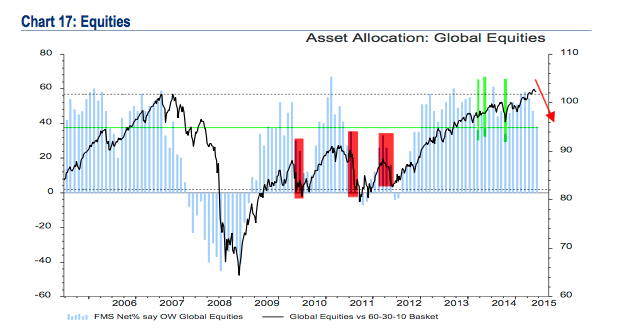
While it sounds like fund managers have become more defensive by reducing their equity allocations, that is somewhat deceiving. As we show below, allocations to the US rose and those to Europe and Japan were mostly unchanged. Instead, nearly all the money in the past month came out of emerging markets.
US exposure was -10% underweight in June, an increase from -19% underweight in May. Since then, US equities have outperformed. US equities are still under-owned and should outperform those in Europe and Japan on a relative basis (see below).
Eurozone exposure was +60% overweight in March, the highest in the survey's history. It declined to a still substantial +46% overweight in June from +49% in May. Judging from the experience in 2006, European equities are likely to underperform. 
Allocations to Japan stayed near the highs of the last few months (+40% overweight). Allocations the past eight months haven't been this high since April 2006. It looks extreme. Managers expect Japan to benefit from central bank liquidity.
Fund managers dropped to -18% underweight emerging markets, almost 2 standard deviations below the mean and at a two-year low. This is where bottoms tend to form.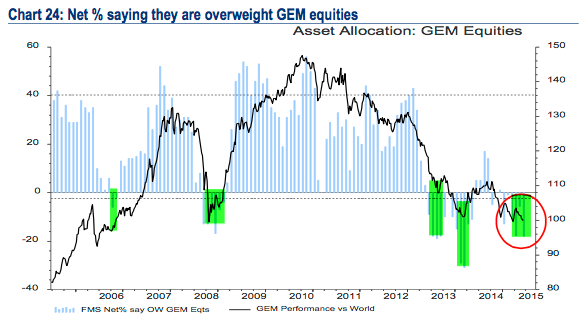
Fund managers are -58% underweight bonds, almost 1 standard deviation below the mean. Bonds continue to be the most underweighted asset class and this, in large part, explains why cash balances have not been lower that 4.5% in two years. For comparison, managers were -38% underweight in May 2013 before the large fall in bond prices.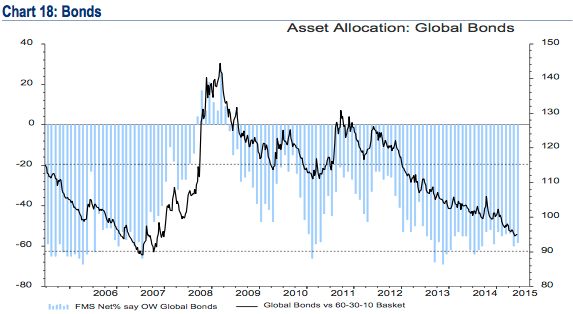
Globally, managers are not just overweight equity and underweight bonds, they are overweight the highest beta equities (technology, discretionary, banks). The largest underweights are in staples and energy.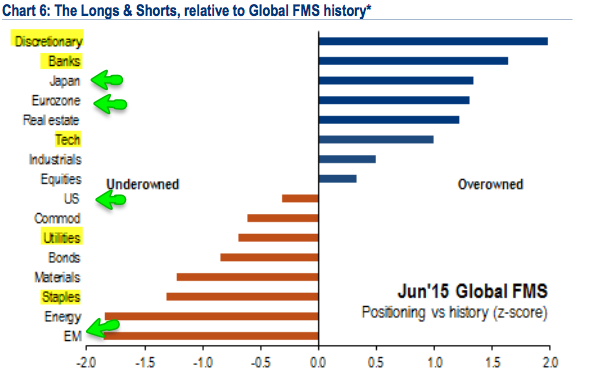
In April, the global overweight in discretionary stocks was the highest since the survey began. It fell slightly in June but is still 2 standard deviations above the long-term mean. Note how discretionary stocks have since underperformed. 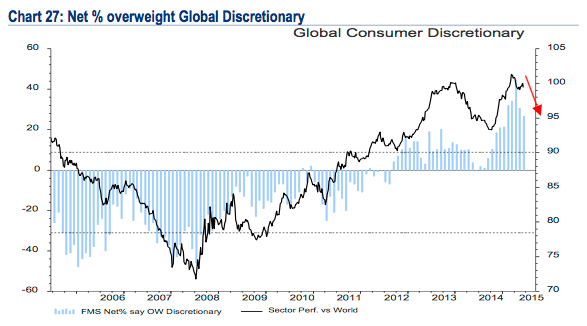
On the other side, the global underweight in consumer staples was the fourth lowest since the survey began. 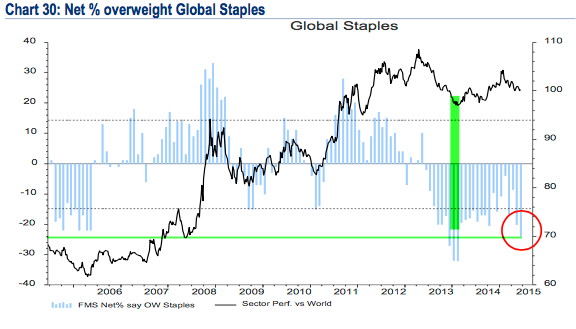
In the US, pharma (biotech), banks and tech are the most favored sectors. This has been the case for many months. Utilities, staples, telecoms (defensives) and energy remain underweighted. 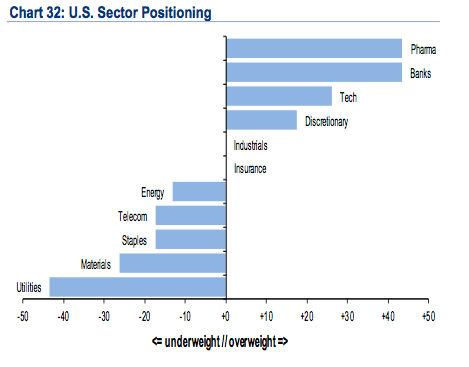
Putting all of the above together, fund managers are long equities (but less than in recent months) and cyclicals relative to cash, bonds and defensives. To counter this, funds have substantially increased their downside hedges. Is this bullish? High levels of hedging corresponded to an equity top in 2008 and lower equity prices in spring 2012 but preceded higher equity prices in mid-2014. There's no clear message from this data.
Survey details are below.
- Cash (+4.9%): Cash balances rose to 4.9%. Typical range is 3.5-5%. BAML has a 4.5% contrarian buy level but we consider over 5% to be a better signal. More on this indicator here.
- Equities (+38%): A net +38% are overweight global equities, down from +47% in May. This is an 8-month low. Over +50% is bearish. A washout low (bullish) would be under +15-20%. More on this indicator here.
- Regions:
- US (-19%): Exposure to the US rose to -10% underweight; it was -19% in May, the lowest since January 2008. For comparison, it was +24% overweight in January.
- Europe (+46%): Exposure to Europe fell slightly to +46% overweight from +49% overweight in May.
- Japan (+40%): Managers are +40% overweight Japan. Funds were -20% underweight in December 2012 when the Japanese rally began.
- EEM (-18%): Managers dropped their EEM exposure to -18% underweight. This is equal to April, the lowest in the past two years.
- Bonds (-58%): A net -58% are now underweight bonds, a small rise from -60% in May. For comparison, they were -38% underweight in May 2013 before the large fall in bond prices.
- Commodities (-11%): Managers commodity exposure increased to -11% underweight from -14% underweight last month. This is a 10-month high. Low commodity exposure goes in hand with low sentiment towards EEM.
- Macro: 55% expect a stronger global economy over the next 12 months. January 2014 was 75%, the highest reading in 3 years. This compares to a net -20% in mid-2012, at the start of the current rally.
